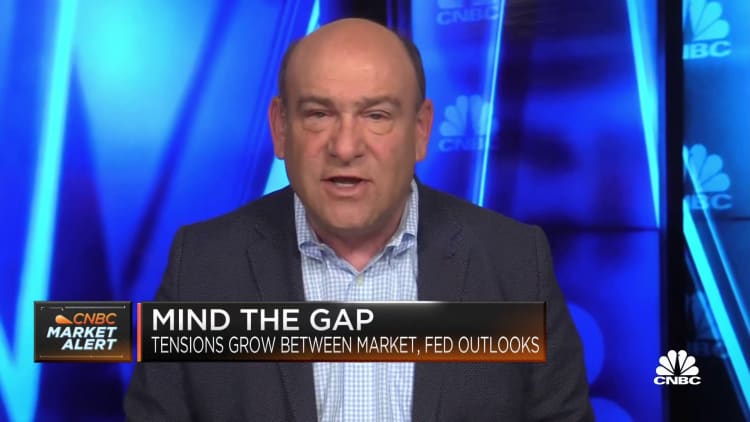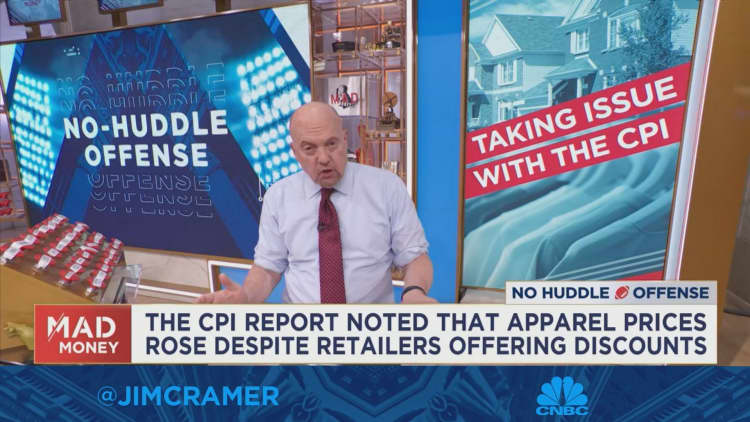[ad_1]
NEW YORK, NEW YORK – JANUARY 12: Eggs are seen on a shelf at Pioneer Supermarkets on January 12, 2023 in the Flatbush neighborhood of Brooklyn borough in New York City. An outbreak of avian influenza, also known as the bird flu, has driven a shortage of eggs as well as an increase in prices in stores throughout some parts of the country. (Photo by Michael M. Santiago/Getty Images)
Michael M. Santiago | Getty Images News | Getty Images
Since the inflation debate began raising toward the “end” of the pandemic, I have made the case that inflation, as the Federal Reserve first suggested, would be transitory.
Transitory never was intended to suggest that a burst of inflation would last only a couple months.
Historically, notwithstanding the 1970s and ’80s, post war/pandemic inflations lasted a couple years before turning substantially lower and sometimes careening back into a bout of deflation.
There is a gathering amount of data to support that position despite the Fed, and many other economists, persistently worrying about an emergent wage/price spiral instead.
The data, to date, simply don’t support those concerns and have been convincingly bolstering the case for a disruptive, but temporary, burst of inflation, the likes of which we have seen after other catastrophic events, like major global conflicts, and/or, prior pandemics.
Let’s look at the supporting data.
First, and most important to all consumers, is the consumer price index itself.
The CPI, which measure of basket of items most frequently purchased by consumers, homes, food, energy, apparel, etc., has not only stopped going up but, as of yesterday’s report, showed its first monthly decline since inflation broke out.
While inflation rose 6.5% on a year-over-year basis, consumer prices, over the last six months, are advancing at a less than 2% annualized rate … right at the Fed’s stated target.
Core consumer prices have also sharply and rapidly descended from their mid-2022 peak.
But wait, there’s more!
The Fed’s preferred measure of inflation the so-called core PCE, (personal consumption expenditures deflator) has also slowed to about a 4% rate, still above the Fed’s target level but down sharply from its post-pandemic high.
In the last three months alone, core inflation annualized at a 3.14% rate, down from 4.5%, on a six-month basis, just prior. All other measures of inflation have followed the same trajectory since June of 2022, though some components, like shelter, have been sticky.
The data used to compute house prices and apartment rents tend to be old and outdated.
Newer measures are showing that like energy, food, manufactured goods and raw commodity prices, the cost of housing has come down and is likely falling far more quickly than official data suggest. Just look at the price of lumber, down to just over $400 per thousand board feet from a peak of over $1,500.
While the Fed has yet to acknowledge these developments, financial markets have.
Inflation expectations, as measured by so-called “breakevens” have plunged. The St. Louis Federal Reserve’s measure of where inflation is expected to be five years from now, as measured by bond market activity, has declined precipitously, from a peak of 3.59% on March 25, 2022, to 2.21%, as of Thursday.
Similar declines are seen in the 10-year breakeven rate.
My friend and colleague, Tom Lee, of Fundstradt, points out that 59% of the CPI’s components are actually deflating, or falling, in price, suggesting more moderation on the inflation front in the months ahead.

We have not yet seen massive declines in service sector inflation, as yet. However, air fares have turned lower and some service pricing is following suit.
Wage inflation, the Fed’s biggest concern of late, has also moderated, suggesting that the much-feared wage/price spiral is not an imminent threat to the economy.
While true that the U.S. labor market has remained remarkably resilient throughout the single most aggressive rate hiking cycle in modern history, layoffs are beginning to accelerate while average hourly earnings, per the most recent jobs report, grew 0.3% last month and have, essentially, moved sideways for the last five months, mirroring all the collected inflation data since then.
It is possible that inflation could reaccelerate, energy prices have bounced a bit lately as China re-opens its economy from a nearly three-year lockdown. Demand for goods and services from China could, conceivably, put upward pressure on prices.
But China’s economy is much more likely to export deflation as it struggles with a massive overhang of unsold housing, a glut of commodities held domestically and a sharp drop in exported goods around the world.
The war in Ukraine, if not ended soon, could also have another adverse impact on energy and food costs, but it is not at all showing up in the data.
In fact, at least domestically, every market indicator is showing more fear of slowing growth than of rising inflation, something the Fed has yet to acknowledge.
The spread between the 3-month T-Bill and the 10-year Treasury note, as of early Friday morning, is 1.1 percentage points. It topped 1¼ percentage points Thursday.
That marks the deepest inversion of the yield curve since the dreaded days of the early 1980s when the U.S. suffered through a very deep “double-dip” recession, caused by a very aggressive Fed, then too, fighting inflation, albeit at much higher rates of inflation.
The markets are not the only indicators saying inflation has peaked, the data, themselves, are making the self-same case.
Inflation is dead. Long live inflation!

[ad_2]
